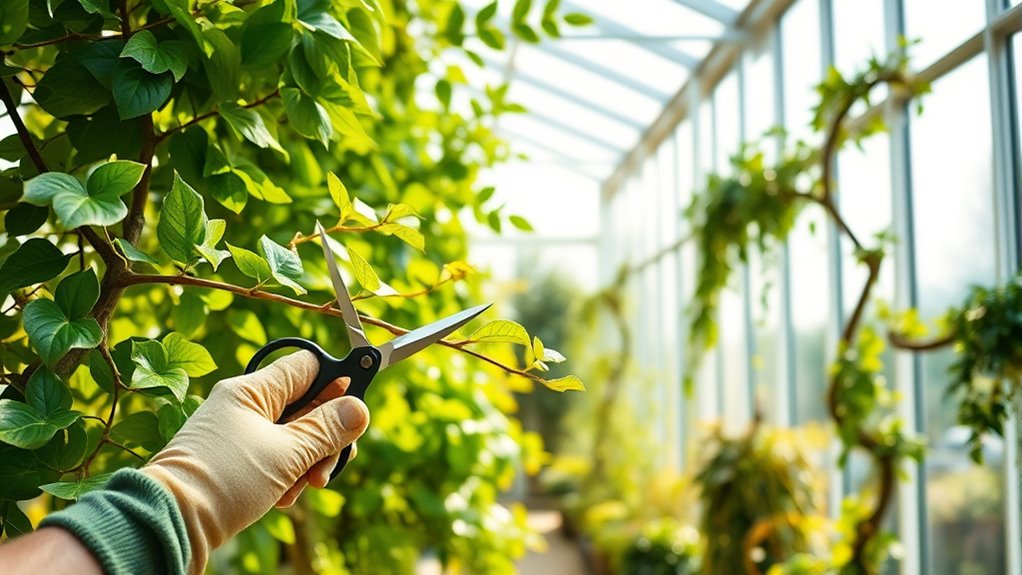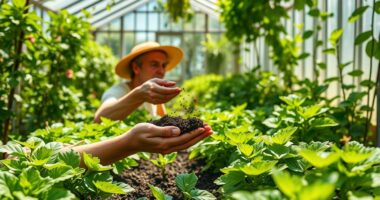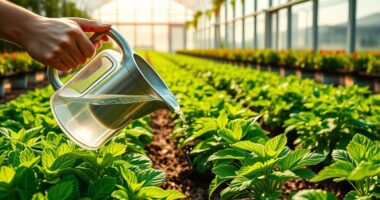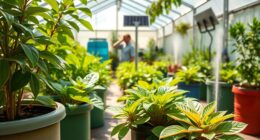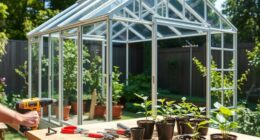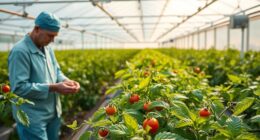To keep your greenhouse plants in shape, you should regularly prune dead or diseased leaves to prevent disease spread and promote healthy growth. Use training techniques like staking or bending stems to shape plants for better light and airflow. Be selective with your cuts and use sharp tools to avoid damage. Consistent pruning and training help manage growth, boost yields, and keep your plants looking vibrant — learn more to master these essential practices.
Key Takeaways
- Regular pruning removes dead or diseased parts to promote healthy growth and prevent disease spread.
- Proper training techniques like staking and bending shape plants for optimal light exposure and airflow.
- Selective pruning directs energy toward flowers or fruits, improving yield and plant vitality.
- Using sharp tools and gentle methods minimizes damage, supporting long-term plant health.
- Consistent maintenance and tailored practices ensure plants stay healthy, productive, and aesthetically pleasing.

Pruning and training are crucial techniques for maximizing your plant’s health and yield. When you actively prune and guide your plants, you’re helping them stay strong, healthy, and productive. Proper pruning removes dead or diseased leaves and stems, preventing the spread of pathogens and encouraging healthy growth. Training, on the other hand, involves shaping the plant to enhance light exposure and airflow, which are critical for vigorous development. Together, these practices ensure your plants remain in prime condition, especially in a greenhouse setting where space and resources are often limited.
Pruning and training optimize plant health, yield, light exposure, and airflow in limited greenhouse spaces.
By focusing on plant health through pruning, you remove unnecessary or damaged growth that could hinder the plant’s overall vitality. This not only improves the aesthetic appearance but also directs the plant’s energy toward producing quality flowers or fruits. When you prune correctly, you promote growth regulation, which controls the size and shape of your plant. This is particularly important in a greenhouse environment, where you want to maximize space and light efficiency. Regular pruning prevents your plants from becoming overly dense, which can lead to issues like mold or pest infestations, ultimately compromising their health. Additionally, understanding the plant physiology behind growth responses can help you tailor your pruning techniques for better results.
Training your plants involves techniques like staking, tying, or bending stems to encourage a desired shape or structure. This process helps you manage growth patterns, ensuring that each part of the plant receives adequate light and air circulation. When you train your plants properly, you’re not only supporting their physical structure but also fostering uniform growth. This uniformity simplifies maintenance and harvest, making your greenhouse operations more efficient. Additionally, training can help in controlling the size of your plants, making them easier to manage and less prone to breakage from wind or their own weight.
The key to successful pruning and training is understanding your specific plant’s needs and growth habits. You want to prune selectively, removing only what’s necessary, and train gently to avoid damaging delicate stems or leaves. Use sharp tools to make clean cuts, reducing the risk of infection. When tying or bending, do so carefully to prevent unnecessary stress on the plant. Incorporating sound knowledge about plant physiology can enhance your pruning and training techniques, ensuring better overall health. Consistent attention to these techniques ensures your plants develop strong, healthy structures, leading to better yields and improved plant longevity. Ultimately, investing time in pruning and training pays off by keeping your greenhouse plants in prime shape, thriving with vibrant growth and abundant harvests.
Frequently Asked Questions
When Is the Best Time to Prune Different Plant Species?
You ask about the best time to prune different plant species. Generally, seasonal pruning works best, so you should prune deciduous plants in late winter or early spring before new growth begins. For flowering plants, follow plant-specific timing—some bloom on old wood, so prune after flowering, while others bloom on new growth, so prune in early spring. Proper timing keeps your plants healthy and thriving.
How Can I Prevent Pests During Pruning and Training?
To prevent pests during pruning and training, you should start by inspecting plants regularly and removing any infested parts promptly. Use biological controls like beneficial insects to naturally manage pests. Choose pest-resistant varieties whenever possible, and sanitize your tools before and after use. Maintaining good airflow and avoiding overwatering also reduces pest risks. These strategies help keep your greenhouse healthy and pest-free during pruning and training.
What Tools Are Safest and Most Effective for Pruning?
You should use sharp scissors or pruning shears for safe, effective pruning. Sharp tools make clean cuts, reducing plant stress and preventing damage. Pruning shears are great for thicker stems, while sharp scissors work well for delicate or small branches. Always sterilize your tools before use to prevent disease spread. With the right, sharp tools, you’ll ensure healthy growth and easier pruning sessions.
How Often Should I Train Plants to Maintain Shape?
Think of your plants as dancers in a performance. To keep their grace, you need to guide their movements. You should train your plants according to their growth cycles, typically every few weeks or as needed during active growth. Establishing consistent pruning schedules helps maintain their shape, encouraging healthy development. By paying attention to their natural rhythms, you make certain they stay vibrant and well-structured, much like a choreographed dance.
Are There Specific Pruning Techniques for Flowering Versus Fruiting Plants?
You should use specific pruning methods depending on whether your plants are flowering or fruiting. For flowering plants, focus on deadheading and light pruning to promote more blooms. For fruiting plants, prune to encourage healthy growth and better fruit production, often involving thinning out older stems. Understanding these differences helps maximize your plants’ health and yield, ensuring you use the right pruning techniques for each type.
Conclusion
Think of pruning and training as tending a garden of your own making. When I first started, I left my plants to grow wild, and they struggled. Once I began shaping and trimming, they thrived, much like a sculptor revealing a masterpiece. Remember, regular care keeps your greenhouse plants healthy and beautiful. With patience and practice, you’ll see your plants flourish, turning your space into a lush, vibrant oasis—proof that a little effort truly shapes success.
